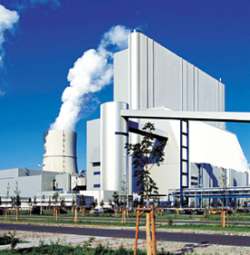Vattenfall has announced plans to reduce the carbon dioxide emissions of its generation portfolio by half by 2030, compared to 1990 levels. President and CEO, Lars G Josefsson made the announcement at Vattenfall's annual general meeting.
Vattenfall has taken a prominant position on climate change issues, founding the Combating Climate Change - A Business Leaders' Initiative (3C), which calls for a global agreement for a market-based approach to tackling climate change.
Vattenfall has already reduced carbon dioxide emissions by 30% since 1990, taking into account the various acquisitions it has made. The new target requires emissions to reduce by a further 20% by 2030. Vattenfall told World Nuclear News that the new 50% target is also likely to take into account any acquisitions or divestments over the period to 2030.
 Vattenfall says that it will achieve its target by upgrading existing power plants, ensuring that future plants are highly efficient and employing forms of emission-free energy production.
Vattenfall says that it will achieve its target by upgrading existing power plants, ensuring that future plants are highly efficient and employing forms of emission-free energy production.
The single most important investment, it says, is Vattenfall's research and development in the field of CCS (carbon capture & storage). Vattenfall began constructing a pilot CCS plant next to the Schwarze Pumpe power station in eastern Germany in 2006.
"Eventually it will be possible to generate electricity in lignite-fired plants without emitting carbon dioxide to the atmosphere - a major contribution to achieving a global solution to the climate problem," said Josefsson.
Vattenfall is investing approximately SEK 600 million ($90 million) in the pilot plant, which is due to be commissioned in 2008.
Over the next four years, Vattenfall will invest a total of SEK134 billion ($19.9 billion) in the development and renewal of its energy production and distribution systems. A large proportion of these investments will go towards the long-term objective of reducing emissions of carbon dioxide from Vattenfall's own plants to zero.
"We will report annually on the company's carbon dioxide emissions, so that the outside world can follow our progress towards achieving the target. By 2030, we should have cut emissions by half compared to the level in 1990. We are using 1990 as the base year as this is also the year used in the Kyoto Protocol and in the European Union's targets. This is a radical change, but it will pay off if a global price is set for carbon dioxide. Staying ahead of the demands set by society will also give us an advantage over our competitors," said Josefsson.
The announcement of this initiative came at a time when the present day climate was blamed in part for a reduction in profits for the first quarter of 2007. Operating profits decreased by 11.8%, to SEK11.2 billion ($1.6 billion), despite net sales rising 9.6% to SEK41.6 billion ($6.2 billion).
Vattenfall said that the fall in profits was largely due to higher costs in the electricity network business - primarily stemming from a powerful storm named Per, which disrupted power lines - and lower margins in the sales operations, prompted by warmer than usual winter weather.
Further information
Vattenfall




_18570.jpg)
_16159.jpg)
_18938.jpg)
_33584.jpg)





